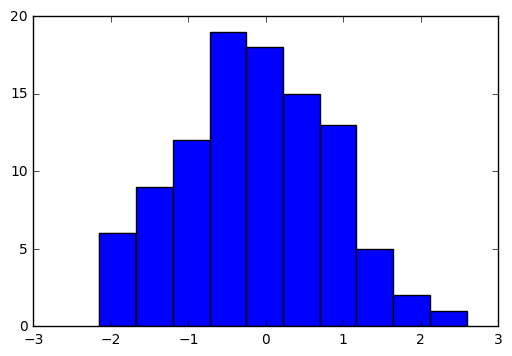Tensorflow之MNIST手寫數字識別:分類問題(1)
阿新 • • 發佈:2018-11-13
一、MNIST資料集讀取
one hot 獨熱編碼
獨熱編碼是一種稀疏向量,其中:一個向量設為1,其他元素均設為0.獨熱編碼常用於表示擁有有限個可能值的字串或識別符號
優點: 1、將離散特徵的取值擴充套件到了歐式空間,離散特徵的某個取值就對應歐式空間的某個點
2、機器學習演算法中,特徵之間距離的計算或相似度的常用計算方法都是基於歐式空間的
3、將離散型特徵使用one_hot編碼,會讓特徵之間的距離計算更加合理
import tensorflow as tf #MNIST資料集讀取 import tensorflow.examples.tutorials.mnist.input_data as input_data mnist= input_data.read_data_sets("MNIST_data/",one_hot=True)
###輸出結果###
#若不成功可手動到相關網站下載之後新增到資料夾中
#Extracting MNIST_data/train-images-idx3-ubyte.gz #Extracting MNIST_data/train-labels-idx1-ubyte.gz #Extracting MNIST_data/t10k-images-idx3-ubyte.gz #Extracting MNIST_data/t10k-labels-idx1-ubyte.gz
二、瞭解MNIST手寫數字識別資料集
#瞭解MNIST手寫數字識別資料集 print('訓練集 train 數量:',mnist.train.num_examples, ',驗證集 validation 數量:',mnist.validation.num_examples, ',測試集 test 數量:',mnist.test.num_examples) ###輸出結果### #訓練集 train 數量: 55000 ,驗證集 validation 數量: 5000 ,測試集 test 數量: 10000
print(' train images shape:',mnist.train.images.shape, 'labels shape:',mnist.train.labels.shape) ###輸出### #train images shape: (55000, 784) labels shape: (55000, 10) #28*28=784,10分類One Hot編碼
三、視覺化image
#視覺化image import matplotlib.pyplot as plt def plot_image(image): plt.imshow(image.reshape(28,28),cmap='binary') plt.show() plot_image(mnist.train.images[1])
輸出結果:

#進一步瞭解reshape() import numpy as np int_array = np.array([i for i in range(64)]) print(int_array)
輸出結果:
[ 0 1 2 3 4 5 6 7 8 9 10 11 12 13 14 15 16 17 18 19 20 21 22 23 24 25 26 27 28 29 30 31 32 33 34 35 36 37 38 39 40 41 42 43 44 45 46 47 48 49 50 51 52 53 54 55 56 57 58 59 60 61 62 63]
int_array.reshape(8,8)
輸出結果:
array([[ 0, 1, 2, 3, 4, 5, 6, 7],
[ 8, 9, 10, 11, 12, 13, 14, 15],
[16, 17, 18, 19, 20, 21, 22, 23],
[24, 25, 26, 27, 28, 29, 30, 31],
[32, 33, 34, 35, 36, 37, 38, 39],
[40, 41, 42, 43, 44, 45, 46, 47],
[48, 49, 50, 51, 52, 53, 54, 55],
[56, 57, 58, 59, 60, 61, 62, 63]])
#行優先,逐列排列 int_array.reshape(4,16)
輸出結果:
array([[ 0, 1, 2, 3, 4, 5, 6, 7, 8, 9, 10, 11, 12, 13, 14, 15],
[16, 17, 18, 19, 20, 21, 22, 23, 24, 25, 26, 27, 28, 29, 30, 31],
[32, 33, 34, 35, 36, 37, 38, 39, 40, 41, 42, 43, 44, 45, 46, 47],
[48, 49, 50, 51, 52, 53, 54, 55, 56, 57, 58, 59, 60, 61, 62, 63]])
plt.imshow(mnist.train.images[20000].reshape(14,56),cmap='binary') plt.show()
輸出結果:
四、資料讀取
1.採用獨熱編碼,標籤資料內容並不是直接輸出值,而是輸出編碼
#標籤資料與獨熱編碼, #內容並不是直接輸出值,而是輸出編碼 mnist.train.labels[1]
輸出結果:
array([ 0., 0., 0., 1., 0., 0., 0., 0., 0., 0.])
#非one_hot編碼的標籤值 mnist_no_one_hot = input_data.read_data_sets("MNIST_data/",one_hot=False) print(mnist_no_one_hot.train.labels[0:10]) #onr_hot = False,直接返回值
輸出結果:
Extracting MNIST_data/train-images-idx3-ubyte.gz Extracting MNIST_data/train-labels-idx1-ubyte.gz Extracting MNIST_data/t10k-images-idx3-ubyte.gz Extracting MNIST_data/t10k-labels-idx1-ubyte.gz [7 3 4 6 1 8 1 0 9 8]
2.讀取驗證集資料
#讀取驗證集資料 print('validation images:',mnist.validation.images.shape,'labels:',mnist.validation.labels.shape)
輸出:
validation images: (5000, 784) labels: (5000, 10)
3.讀取測試機資料
#讀取測試機資料 print('tast images:',mnist.test.images.shape,'labels:',mnist.test.labels.shape)
輸出結果:
tast images: (10000, 784) labels: (10000, 10)
4.一次批量讀取多條資料
#一次批量讀取多條資料 batch_image_xs,batch_labels_ys = mnist.train.next_batch(batch_size=10) #next_batch()實現內部會對資料集先做shuffle print(mnist.train.labels[0:10]) print("\n") print(batch_labels_ys)
輸出結果:
[[ 0. 0. 0. 1. 0. 0. 0. 0. 0. 0.] [ 0. 0. 0. 0. 0. 0. 1. 0. 0. 0.] [ 0. 0. 0. 0. 0. 0. 0. 1. 0. 0.] [ 0. 0. 0. 0. 0. 0. 0. 1. 0. 0.] [ 0. 0. 0. 0. 0. 0. 0. 1. 0. 0.] [ 0. 0. 0. 0. 0. 0. 0. 0. 0. 1.] [ 0. 0. 0. 0. 1. 0. 0. 0. 0. 0.] [ 0. 0. 0. 0. 0. 0. 0. 0. 1. 0.] [ 0. 0. 0. 0. 0. 0. 0. 0. 0. 1.] [ 0. 0. 0. 0. 0. 0. 0. 0. 0. 1.]] [[ 0. 0. 0. 0. 0. 0. 1. 0. 0. 0.] [ 0. 0. 0. 0. 0. 1. 0. 0. 0. 0.] [ 0. 0. 0. 0. 0. 0. 0. 1. 0. 0.] [ 0. 1. 0. 0. 0. 0. 0. 0. 0. 0.] [ 0. 0. 0. 0. 0. 0. 0. 0. 0. 1.] [ 0. 0. 0. 1. 0. 0. 0. 0. 0. 0.] [ 0. 1. 0. 0. 0. 0. 0. 0. 0. 0.] [ 0. 0. 0. 0. 0. 0. 0. 0. 1. 0.] [ 1. 0. 0. 0. 0. 0. 0. 0. 0. 0.] [ 0. 0. 0. 0. 0. 0. 0. 1. 0. 0.]]
5.argmax()用法
argmax返回的是最大數的索引
import numpy as np np.array(mnist.train.labels[1]) np.argmax(mnist.train.labels[1]) #argmax返回的是最大數的索引
#argmax詳解 arr1 = np.array([1,3,2,5,7,0]) arr2 = np.array([[1,2,3],[3,2,1],[4,7,2],[8,3,2]]) print("arr1=",arr1) print("arr2=",arr2) argmax_1 = tf.argmax(arr1) argmax_20 = tf.argmax(arr2,0) #指定第二個引數為0,按第一維(行)的元素取值,即同列的每一行取值 以行為基準,每列取最大值的下標 argmax_21 = tf.argmax(arr2,1) #指定第二個引數為1,則第二維(列)的元素取值,即同行的每一列取值 以列為基準,每行取最大值的下標 argmax_22 = tf.argmax(arr2,-1) #指定第二個引數為-1,則第最後維的元素取值 with tf.Session() as sess: print(argmax_1.eval()) print(argmax_20.eval()) print(argmax_21.eval()) print(argmax_22.eval())
輸出結果:
arr1= [1 3 2 5 7 0] arr2= [[1 2 3] [3 2 1] [4 7 2] [8 3 2]] 4 [3 2 0] [2 0 1 0] [2 0 1 0]
五、視覺化
#定義視覺化函式 import matplotlib.pyplot as plt import numpy as np def plot_images_labels_prediction(images,labels,prediction,index,num=10): #引數: 圖形列表,標籤列表,預測值列表,從第index個開始顯示,預設一次顯示10幅 fig = plt.gcf() #獲取當前圖表,Get Current Figure fig.set_size_inches(10,12) #1英寸等於2.45cm if num > 25 : #最多顯示25個子圖 num = 25 for i in range(0,num): ax = plt.subplot(5,5,i+1) #獲取當前要處理的子圖 ax.imshow(np.reshape(images[index],(28,28)), cmap = 'binary') #顯示第index個影象 title = "labels="+str(np.argmax(labels[index])) #構建該圖上要顯示的title資訊 if len(prediction)>0: title += ",predict="+str(prediction[index]) ax.set_title(title,fontsize=10) #顯示圖上的title資訊 ax.set_xticks([]) #不顯示座標軸 ax.set_yticks([]) index += 1 plt.show() #視覺化預測結果 # plot_images_labels_prediction(mnist.test.images,mnist.test.labels,prediction_result,10,10) plot_images_labels_prediction(mnist.test.images,mnist.test.labels,prediction_result,10,25)
六、評估與應用
#評估模型 #完成訓練後,在測試集上評估模型的準確率 accu_test = sess.run(accuracy,feed_dict={x:mnist.test.images,y:mnist.test.labels}) print("Test Accuracy:",accu_test) #完成訓練後,在驗證集上評估模型的準確率 accu_validation = sess.run(accuracy,feed_dict={x:mnist.validation.images,y:mnist.validation.labels}) print("Test Accuracy:",accu_validation) #完成訓練後,在訓練集上評估模型的準確率 accu_train = sess.run(accuracy,feed_dict={x:mnist.train.images,y:mnist.train.labels}) print("Test Accuracy:",accu_train)
#應用模型 #在建立模型並進行訓練後,若認為準確率可以接受,則可以使用此模型進行預測 #由於pred預測結果是one_hot編碼格式,所以需要轉換成0~9數字 prediction_result = sess.run(tf.argmax(pred,1),feed_dict={x:mnist.test.images}) #檢視預測結果中的前10項 prediction_result[0:10]
七、tf.random_normal()介紹
#tf.random_normal()介紹 norm = tf.random_normal([100]) #生成100個隨機數 with tf.Session() as sess: norm_data = norm.eval() print(norm_data[:10]) import matplotlib.pyplot as plt plt.hist(norm_data) plt.show()
輸出結果:
[-1.20503342 -0.40912333 1.02314627 0.91239542 -0.44498116 1.46095467 1.71958613 -0.02297023 -0.04446657 -1.58943892]


